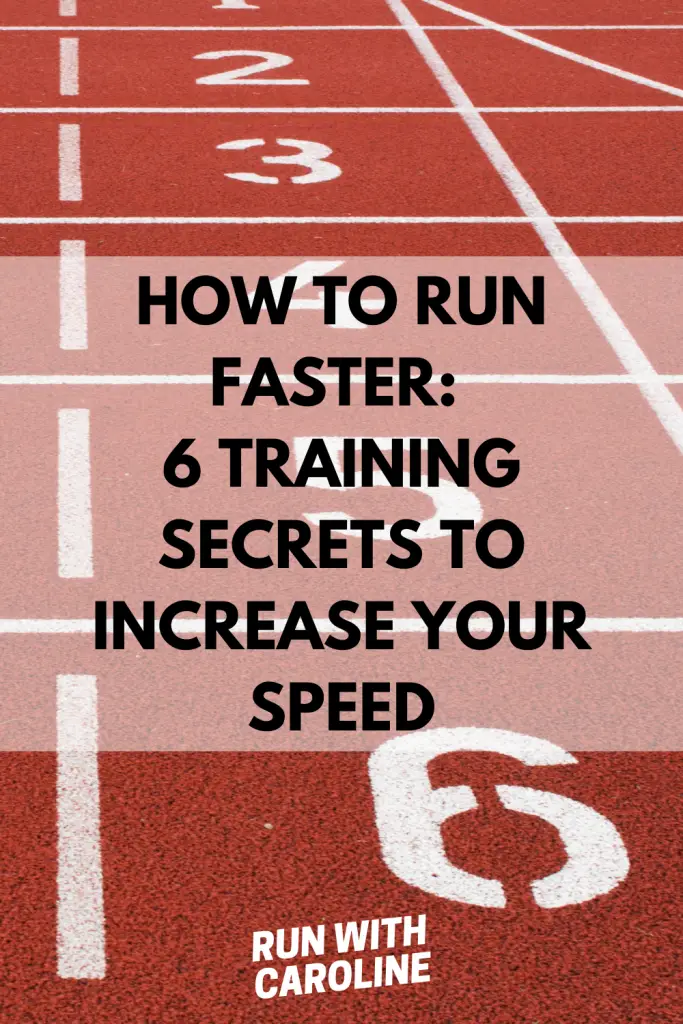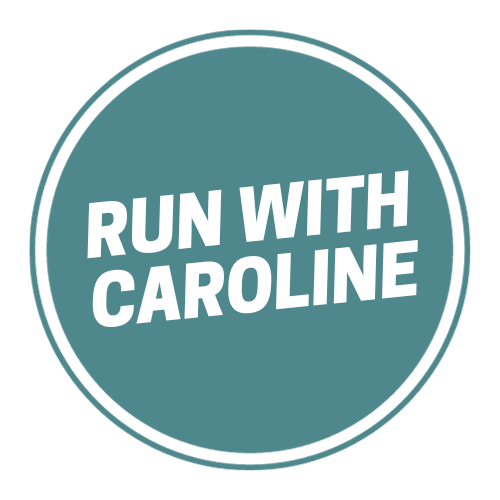A common goal for a lot of runners is to be able to run faster.
After all, you know how good it feels to run a personal best!
There are many tips out there on how to run faster, but what if you feel like you’re just not getting anywhere?
You may feel like you’re stuck in a running rut, despite all the training and miles you’re putting in each week.
If you’re not seeing any improvement in your speed or race times, the good news is that there are lots of things you can do to help you run faster and improve your speed.
In this guide we’ll look at some of the things you could be doing to improve your speed and your race times.
We’ll explore:
- The factors that affect running speed
- How to run faster and longer
- How to run faster without getting tired
- How to run a faster 5k
- How to run a faster 10k
- How to run a faster half marathon
- Tips on how to run faster
- 4 speed training workouts to help you run faster
Ready?
Let’s get to work!

The factors that affect running speed
The reality is, running speed and being able to run faster come down to a number of factors.
All of these factors will affect how fast you can run.
These factors include:
- Your age, gender and weight
- Your fitness levels
- Your running experience
- Any previous race times
- Your injury and/or medical history
All of these factors need to be taken into consideration when training to run faster.
For example, if you’re a beginner runner, you won’t be running at the same speed as someone who has been running for several years, so bear this in mind before comparing yourself to others.
The key is to find a training plan/routine that works for you and your own goals – more on those below.
Related: 5 workouts to help you run a faster 5k
How to run faster
There are two key stages when it comes to running faster.
The golden rule is that speed always follows endurance, which means you need to build a solid base of fitness before improving your speed.
Stage 1: Improve your endurance and stamina
When it comes to running faster, you need to have a solid base from which to work from.
This means improving your endurance and stamina.
In order to increase running stamina and endurance, you need to train consistently and progress at regular intervals.
By training consistently, you increase your aerobic capacity (also known as your VO2 max or running economy) and strengthen your muscles.
Experts recommend getting at least 150 minutes of aerobic activity per week.
Exercising more than 150 minutes per week is linked to additional health benefits.
Begin by adding extra runs into your training plan each week.
The key here is to include easy runs as well as one long run each week – typically done on a weekend.
Aim to include 3 to 4 easy runs each week, each run should be 30 minutes or more.
Stage 2: Improve your speed
Once you have built up your stamina and endurance, it’s time to incorporate some speed training into your training.
Speed training (also known as speedwork) is one of the best ways to increase running speed.
If you’re sticking to the same pace week in, week out, now is the time to switch things up!
You need to get your body used to running at a faster pace during training in order to reap the benefits on the race track.
Strides, tempo running, Fartlek training, interval training and hill sprints are all great forms of speed training.
All these forms of speed training can be adapted for any level of runner, from beginner to advanced.
However, if you’re new to speed training, then I suggest you start with strides.
At the end of this guide you will find 4 sample speed training workouts.
Strides
Strides are short bursts of running at an accelerated speed.
They are a great form of speed training for new runners and beginner runners.
The idea is that you start with a jog then build to about 95% of your maximum speed, then gradually come to a stop.
One stride should take you about 25-30 seconds depending on your running ability.
Strides are easy to include in your weekly routine as they can be done before a run as a warm up, in the middle of a run, or after an easy run to work on form.
Tempo running
Tempo running (also known as a ‘threshold running’) is done at a pace about 25 to 30 seconds slower than your 5k race pace.
It is designed to be a challenging pace, but not so much that you’re full out sprinting.
Fartlek training
Fartlek training (which is the Swedish term for ‘speed play’) is a blend of interval training and distance running.
It involves continuous periods of faster running intermixed with periods of easy running.
Whilst tempo running is a structured form of speed training, Fartlek training in unstructured, which makes it a little more fun.
Interval training
Interval training is alternate periods of high and low intensity running.
It helps you to improve your speed and endurance to help you run faster and more efficiently.
A 2018 study even showed that by incorporating six interval training sessions in their training routine, trained athletes were able to improve their running performance and significantly increase their maximal aerobic speed.
Hill sprints
Running up hills is one of the most effective ways to increase your speed and build your muscle, stamina, endurance and VO2 Max.
Hill sprint workouts use different energy systems (lactate and creatine phosphate) which involve more explosive movement in order to get your body up the hill.
The idea is that you run up a hill of about 100-200 metres long at your 5k pace, then recover running or walking downhill.
As you approach the hill, make sure:
- Your arms are at a 90-degree angle and moving forward and back (not across your body).
- Your back is straight. You can lean very slightly forward from the hips as you run up the hill, but make sure you’re not hunched.
If you’re a beginner runner, I suggest you do 2 to 3 repeats, and 6 to 10 repeats if you’re an advanced runner.
When you speedwork like tempo running and Fartlek training into your training routine, the idea is that you gradually build up speed and endurance.
When running at a faster pace for longer periods, you will notice physiological changes in your body which at first may feel challenging, if not strange.
However, with consistency and practice, you will soon reap the benefits of speed training.
Whilst these types of speed training workouts are great for runners, it’s important that you don’t forget about the long run!
The bottom line? When you combine long runs with speed training sessions, you will soon reap the benefits.
Related: 7 of the best running workouts to build endurance, strength and speed

How to run a faster 5k
Being able to run a faster 5k starts with a 5k training plan.
There are many training plans out there and the key is to find one that suits your running experience and fitness levels.
Here are some sample 5k training plans to get you started:
A well-rounded 5k training plan will include the following:
- 1 to 3 easy runs
- 1 long run
- 1 speed training session (e.g. interval training or strides)
- 1 strength training and/or cross training session (optional)
Related: What to expect running 30 minutes a day (and how to start)
How to run a faster 10k
As with 5k training, when it comes to running a faster 10k, your best bet is to find a suitable training plan.
Although you are running effectively double the distance.
A 10k in miles is 6.2 miles, so you will need to build up your endurance and stamina before working on your speed.
I have included links below to my most popular 10k training plans:
A good 10k training plan will include the following:
- 2 to 3 easy runs
- 1 long run
- 1 to 2 speed training sessions (e.g. interval training or tempo running)
- 1 strength training or cross training session
Related: 11 things I wish I’d known before running my first 10k
How to run a faster half marathon
When it comes to running a faster half marathon, there are a lot more factors to consider.
A half marathon in miles is 13.1 miles so maintaining your 5k or 10k pace during a half marathon will take its toll after a while, so you need to approach half marathon training differently.
When you step up from a 5k or 10k race to a half marathon, adaptations in your body need to take place.
You can find more half marathon tips in my guide on how to run a half marathon in 2 hours or less.
You can also find my half marathon training plans below:
Related: The ultimate couch to half marathon training plan

Tips on how to run faster: 6 training secrets every runner needs to know
#1 Set yourself SMART goals
When training to increase your speed, the key is to be realistic in terms of how much faster you want to run and set yourself achievable goals.
For example, if you’re already running a 35-minute 5k, it’s probably unwise to expect to be able to run a sub-25 minute 5k in a matter of weeks.
Likewise, if you regularly run a half marathon in 2 hours or less, then shaving off 25-30 minutes of this race time in a matter of months is a huge ask.
This is where ‘S.M.A.R.T’ goals come in. ‘S.M.A.R.T’ stands for:
- Specific
- Measurable
- Attainable
- Relevant
- Time-Bound
Use the S.M.A.R.T framework to help you set targeted goals, not vague or unspecific goals.
For example, instead of setting a goal such as “I want to run faster”, you can use the S.M.A.R.T framework to really narrow down your goal and make it specific and relevant to you.
Here are some example running goals using the S.M.A.R.T framework:
- “I want to run 5k in 30 minutes or less by August.”
- “I want to run 10k in 60 minutes or less by October.”
- “I want to run a half marathon 15 minutes faster by September.”
Once you’ve really thought about what your goal looks like, you’ll also become much more accountable for the goal and more motivated to achieve it.
And remember that the key to any form of goal setting, whether it be for your professional or personal life, is making it real for YOU and nobody else.
Related: 5 important things to remember when setting effective running goals
#2 Improve your running form
One of the key elements that will help you run faster for longer is proper running form.
Running form is important because it helps you run in the most efficient way possible, in a way that places less stress and pressure on your body.
Improper running form can create imbalances in your muscles which can lead to inefficient performance and a higher risk of injury.
Inefficient performance equals slower race times.
The following elements make up proper running form:
- Posture
- Arm swing
- Core
- Cadence
- Footstrike
Together, these elements benefit you and make you a stronger, faster and more efficient runner.
One of the best ways to improve your running form is to practice running drills on a regular basis.
Running drills are essentially dynamic exercises that focus on running technique and help you develop the technical skills needed for the proper movement patterns needed for running.
You can complete running drills as part of a warm up before a run, or standalone if you really want to improve an element of your running form.
#3 Strength train
Strength training is something I’d recommend to any runner who is looking to run faster for longer, no matter whether they’re training for a 5k or ultra marathon.
Two short strength training sessions a week can go a long way to help you run faster and increase your speed.
Whilst strength training is not the most obvious choice for runners when wanting to run faster, the truth is it makes you a stronger, faster and more efficient runner, as well as helping to prevent common running injuries.
Some good strength workouts for runners include:
- Squat
- Forward lunge
- Push-up
- Plank
- Hip bridge
You can also add weights to these to make them more challenging.
Check out my 30 day strength training plan for more tips and advice.

#4 Take rest and injury prevention seriously
Rest and recovery is equally as important as running itself when it comes to being able to run faster for longer.
Take rest days seriously in your training plan, and don’t be tempted to run or speed train on your rest days as they are there for a reason.
Stretching, foam rolling, nutrition and adequate hydration should all form part of a proper recovery strategy.
Likewise, the last thing a runner wants or needs is an injury, but with a good injury prevention strategy you can learn to stop injuries happening in the first place.
By paying attention to your body and adding a few simple things into your training routine, you can avoid a lot of common overuse injuries like IT band syndrome and shin splints.
A good injury prevention strategy is essential for any runner looking to feel good and run strong week in, week out.
#5 Fuel your runs properly
Proper nutrition is key for any runner, especially when running faster efforts and running more times each week.
And when you level up your training plan, you need to ensure you are fuelling your body properly to cope with this extra energy demand.
All the energy you are releasing needs to be replenished, and the best way to do this is through food!
Aim to eat a carb-based meal before a long run to ensure you have enough energy to cover the distance.
If you feel cranky or unable to complete a run, this may be a sign that you are fuelling your body in the right way.
After each run make sure you are eating enough protein to help repair your muscles and tissues.
#6 Try HIIT
HIIT stands for high intensity interval training and involves quick bursts of exercise followed by short, sometimes active, recovery periods.
It differs from a regular workout in that you push yourself to to 90 per cent of your personal max effort during the high intensity intervals.
High intensity interval training works best when you work for 40 seconds at your max effort, then rest for 20 seconds, and repeat this pattern for 5 to 10 sets.
I normally include strength exercises like burpees, squats, push ups and on the spot sprints in my HIIT workouts.
Related: The best HIIT running workouts to do today to lose weight

3 speed training workouts to help you run faster
Each of these speed training workouts uses ‘easy’ and ‘fast’ efforts:
- Easy efforts should be run at a steady pace so you can comfortably hold a conversation without getting out of breath. Think 4 to 6 out of 10 on the effort scale.
- Fast efforts (done during the running interval) should be run at a very challenging pace that takes you out of your comfort zone. Think 7 to 8 out of 10 on the effort scale.
#1 Interval training workout
With this workout you can choose to measure each interval by either time or distance:
- 6 x 1 or 2 minute intervals, broken up with a light jog or walk
- 6 x 400m or 600m intervals, broken up with a light jog or walk
#2 Fartlek training workout
With this workout you can choose to measure each interval by either time or distance:
- Run 1 minute at a faster effort, then run 3 minutes at an easy effort. Repeat 3 times.
- Run for half a mile at a faster effort, then run for half a mile at an easy effort. Repeat 3 times.
#3 Tempo running workout
Tempo running involves periods of steady and prolonged running at a comfortably hard pace.
The easiest way to determine a proper tempo pace is to add 24 to 30 seconds per mile to your 5k race pace.
A tempo run should not feel like a race at any point.
At the beginning of the workout your breathing may seem labored, but as your body adjusts to the pace you should begin to feel more in control.
- Run 10 minutes at an easy effort.
- Run 20-30 minutes at a faster effort.
- Run 10 minutes at an easy effort.
#4 Strides workout
Strides are a great addition to a warm up before a 5k or 10k, or can be done as part of a standalone session.
- Start by running easy then gradually increase your speed until you’re at 95% of your maximum speed.
- Once you’ve run three quarters of the distance, start to slow down by shortening your stride until you come to a gentle jog then walk.
- Walk back to the starting point and use this time to recover and catch your breath.
- Alternatively, wait on the spot then turn around and run the stride again.
More tips on how to run faster:
- 6 interval training benefits for runners
- What is a tempo run? 5 tempo workouts for runners
- Run faster and improve your form: How to run strides
- 5 things I wish I’d known before returning to running - March 3, 2024
- Running 20 minutes a day: Benefits + how to start - January 27, 2024
- How to run your first 2 hour half marathon - January 16, 2024
